Middle English Period 1066-1400 AD Part 2
Geoffrey Chaucer and the Flowering of Middle English Literature
From The Professor's Desk
In any history of English literature, certain figures stand as defining voices of their age — and in the Middle English period, none looms larger than Geoffrey Chaucer. Born in the early 1340s, Chaucer lived through some of the most turbulent decades in England’s medieval history — decades marked by plague, political unrest, and profound social change. Yet out of this complex world, he crafted a body of work that not only captured the spirit of his time but shaped the course of English literature for centuries to follow.
Chaucer’s genius lay not only in his mastery of language but in his keen observation of the human condition. Through works such as The Canterbury Tales, Troilus and Criseyde, The Book of the Duchess, The House of Fame, The Parliament of Fowls, and The Legend of Good Women, Chaucer gave voice to a remarkably diverse array of characters, moods, and philosophical reflections. His command of narrative form, his engagement with European literary traditions, and his elevation of Middle English to a medium of poetic sophistication marked a decisive moment in the evolution of English literary expression.
In this section, we explore the life, works, and enduring legacy of Geoffrey Chaucer — a poet who transformed the literary landscape of his nation and whose influence resonates to this day.
Professor’s Perspective on Chaucer
To read Chaucer is to encounter a writer who understood that literature must embrace the fullness of life — its virtues, its follies, its ironies. In an age often marked by rigid hierarchies and moral certainties, Chaucer’s works present a more fluid and humane vision. His characters speak in many voices — courtly and common, pious and profane — and through them, Chaucer invites us to recognise the enduring complexities of human nature.
As students of literature, we must not approach Chaucer as a relic of the medieval world, but as a writer of remarkable modernity — one who understood that the power of storytelling lies in its capacity to bridge the divisions of class, culture, and time. In every age, Chaucer reminds us that the tales we tell — and the way we tell them — remain our most vital inheritance.
Geoffrey Chaucer (c. 1343-1400)
Geoffrey Chaucer (c. 1343-1400) was an English poet and writer often referred to as the “Father of English Literature.” He is best known for his masterpiece, “The Canterbury Tales,” a collection of stories that provides a vivid snapshot of medieval society and culture. Chaucer’s life and works offer valuable insights into the social, cultural, and literary landscape of his time.
Birth and Family: Chaucer was likely born around 1343 in London, England, to a relatively affluent family with connections to the court. His father was a wine merchant, and Chaucer’s early life exposed him to courtly and merchant circles.
Education and Career: Chaucer received a good education and held various administrative and diplomatic positions throughout his life. He worked as a squire, diplomat, customs official, and comptroller of the wool customs, among other roles.
Royal Service: Chaucer’s diplomatic missions took him to various parts of Europe, allowing him to observe different cultures and societies. He was exposed to the courtly culture of England, the Italian Renaissance, and the emerging literary traditions of France.
Literary Influence: Chaucer was well-read in various languages and literary traditions. His exposure to French and Italian literature influenced his writing style and themes.
Geoffrey Chaucer’s life can be divided into three main phases:
1. Early Life and Education:
Chaucer was born around 1343 into a family of middle-class London merchants. Little is known about his early years, but it’s believed that he received a good education, likely attending the St. Paul’s Cathedral School. This education provided him with a foundation in literature, languages, and classical works. He might have also been exposed to the works of Italian poets, which would later influence his writing.
2. Government Service and Middle Years:
In the second phase of his life, Chaucer entered into public service. He held various administrative positions, which brought him into close contact with royalty and the upper echelons of society. He served as a page, a soldier, a diplomat, and a customs official. He was also sent on diplomatic missions abroad, including to Italy, where he would have been exposed to the works of Boccaccio and Petrarch. This exposure influenced his writing style and introduced him to the literary concepts of the Italian Renaissance.
During this period, Chaucer began to write his major works, including “The Canterbury Tales.” This collection of stories, written in English rather than Latin or French, marked a significant shift in literature, as it helped establish English as a legitimate literary language.
3. Later Years and Literary Accomplishments:
In his later years, Chaucer experienced personal and professional challenges. He faced financial difficulties due to political changes and his royal pensions being reduced or suspended. Despite these challenges, he continued to write and translate, contributing to his legacy as a poet and writer.
One of his last and most notable works was “The Canterbury Tales.” Although he did not complete the entire collection as planned, this work remains a literary masterpiece and a vivid portrayal of medieval society. Chaucer’s writing in “The Canterbury Tales” displays his skill in characterization, narrative innovation, and commentary on various aspects of human nature.
Chaucer’s contributions to English literature and his innovative use of vernacular language helped lay the foundation for the development of English as a literary language. He passed away on October 25, 1400, and his tomb in Westminster Abbey reflects his status as one of the early greats of English literature.
Works:
The Canterbury Tales: Chaucer’s magnum opus is “The Canterbury Tales,” a collection of stories framed within a narrative about a group of pilgrims traveling to the shrine of Thomas Becket in Canterbury Cathedral. The pilgrims each tell a story during the journey, creating a rich tapestry of narratives that encompass various genres, themes, and characters. The work is known for its realism, humor, and social commentary.
Troilus and Criseyde: This is a narrative poem based on a story from the Trojan War. It explores themes of love, honor, and fate. Chaucer’s portrayal of Troilus and Criseyde’s relationship offers a nuanced view of courtly love.
The Book of the Duchess: This elegiac poem reflects on the death of John of Gaunt’s wife, Blanche. It blends dream vision with allegory.
Other Works: Chaucer also wrote shorter poems, such as “The Parliament of Fowls,” “The House of Fame,” and “The Legend of Good Women.” His works showcase his versatility as a writer and his exploration of different genres.
Society and Cultural Context:
Feudal Hierarchy: Chaucer lived during a time of feudalism, where society was organized in a hierarchical manner, with the king at the top and different classes of nobility, clergy, and commoners beneath.
Courtly Love: Courtly love was a prominent cultural theme during Chaucer’s time. His works often explore the conventions and complexities of love and relationships within the context of medieval courtly culture.
Religion and Pilgrimage: Religious devotion was a central aspect of medieval life. “The Canterbury Tales” reflects the importance of pilgrimage and the role of religion in people’s lives.
Social Diversity: Chaucer’s works capture the diversity of medieval society, from the nobility and clergy to the emerging middle class and commoners.
Chaucer’s ability to capture the essence of his society, combined with his linguistic innovation and narrative skill, solidifies his status as a seminal figure in English literature. His works continue to be studied for their historical, cultural, and literary significance.
“Troilus and Criseyde”
“Troilus and Criseyde” is a Middle English narrative poem by Geoffrey Chaucer that tells the tragic love story of Troilus, a Trojan prince, and Criseyde, a widow and daughter of a Trojan seer. Set during the Trojan War, the poem explores themes of love, honor, fate, and human emotion.
“Troilus and Criseyde” is a major narrative poem written by Geoffrey Chaucer during the late 14th century. The work is considered one of Chaucer’s most accomplished and influential pieces, showcasing his skill in blending romance, tragedy, and psychological insight. It is based on a story from classical antiquity and explores themes of love, honor, fate, and the complexities of human emotion.
Book I:
The poem begins with an invocation to the god of love. The story unfolds in the city of Troy, where Troilus, the younger brother of Hector, falls deeply in love with Criseyde, who has recently moved to Troy from the Greek camp. Troilus’s feelings are described in terms of courtly love, and his friend Pandarus encourages his pursuit of Criseyde.
Book II:
Pandarus acts as the intermediary between Troilus and Criseyde, skillfully arranging their meetings and interactions. Troilus’s love for Criseyde intensifies, and Criseyde begins to feel a similar affection for him. Pandarus continues to manipulate events to bring them together.
Book III:
Amid the Trojan War, Criseyde’s father, Calchas, a seer who switched sides to the Greeks, arranges for a prisoner exchange. Criseyde is sent to the Greek camp, leaving Troilus devastated. Troilus is consumed by grief and writes sad songs of his sorrow.
Book IV:
In the Greek camp, Criseyde is courted by Diomede, a Greek warrior. She initially resists his advances but eventually succumbs to his charms. Meanwhile, Troilus is heartbroken and confronts his own emotional turmoil.
Book V:
Despite Troilus’s grief, Pandarus convinces him that Criseyde will return to him. Troilus seeks solace in his faith in the planets and gods. However, Criseyde’s decision to be with Diomede becomes apparent, causing Troilus to despair. The poem ends on a somber note, emphasizing the fleeting nature of human happiness.
Themes and Interpretation:
“Troilus and Criseyde” explores themes of love, fate, honor, and the complexities of human emotion. The poem presents a nuanced examination of courtly love, showing both its idealized beauty and its painful consequences. The influence of fate and fortune is evident as the characters navigate their paths within the larger context of the Trojan War. The poem’s exploration of the human psyche and the characters’ inner thoughts adds psychological depth to the narrative.
Chaucer’s work bridges the gap between the courtly romance tradition of earlier medieval literature and the psychological realism of later literature. Through the story of Troilus and Criseyde, Chaucer delves into the multifaceted nature of love, desire, and human vulnerability, creating a narrative that resonates across time and culture.
Plot and Setting: The poem is set during the Trojan War and tells the story of the tragic love affair between Troilus, a Trojan prince, and Criseyde, a widow and the daughter of a Trojan seer. The poem unfolds against the backdrop of the war between the Greeks and the Trojans.
Characters:
Troilus: The young and valiant Trojan prince who falls deeply in love with Criseyde.
Criseyde: A beautiful and intelligent widow who captures Troilus’s heart but is ultimately separated from him due to political circumstances.
Pandarus: Criseyde’s uncle and a close friend of Troilus. He plays a role in bringing the two lovers together.
Diomede: A Greek warrior who becomes romantically involved with Criseyde after she is sent to the Greek camp.
Themes:
Love and Courtly Romance: The poem explores the concept of courtly love, a stylized form of love characterized by devotion, service, and idealization of the beloved. Troilus’s love for Criseyde embodies these courtly ideals.
Fate and Fortune: Chaucer examines the role of fate and fortune in human lives. Despite their love, Troilus and Criseyde’s separation is determined by larger political forces.
Moral Ambiguity: The poem delves into the moral complexities of human behavior. Characters’ decisions often challenge traditional notions of honor and virtue.
Narrative Structure: “Troilus and Criseyde” is written in rhyme royal, a seven-line stanza form used by Chaucer. It consists of five books, each containing a substantial number of stanzas. The poem’s structure allows for detailed character development and exploration of themes.
Psychological Realism: Chaucer’s portrayal of characters’ inner thoughts and emotions is a notable feature of the poem. He delves into the psychological aspects of love, jealousy, and despair.
Influence and Reception: “Troilus and Criseyde” is an adaptation of the ancient Roman poet Boccaccio’s work “Il Filostrato.” Chaucer’s version, however, adds depth, psychological insight, and linguistic innovation. The poem had a significant impact on later works of English literature, including Shakespeare’s “Troilus and Cressida.”
Significance: The poem reflects the shifting cultural and literary landscape of Chaucer’s time, transitioning from medieval courtly romance to more complex psychological explorations. It highlights Chaucer’s skill in capturing the subtleties of human experience.
“Troilus and Criseyde” is a testament to Chaucer’s mastery of narrative, characterization, and thematic exploration. It remains an important work in the canon of English literature and offers valuable insights into the complexities of love and human nature.
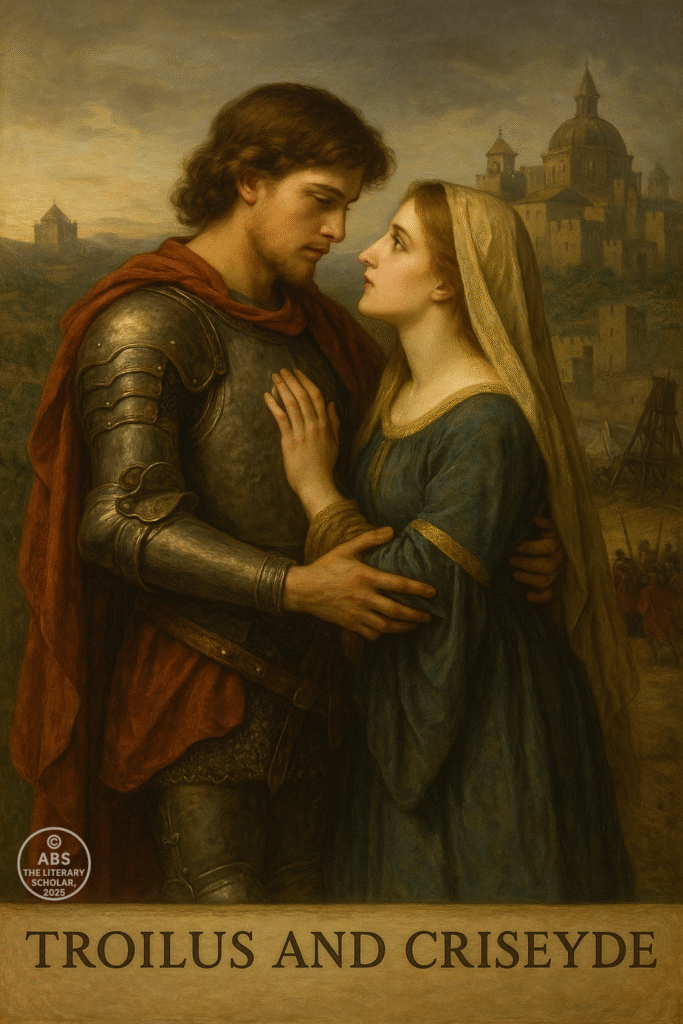
“The Book of the Duchess”
“The Book of the Duchess” is a narrative poem written by Geoffrey Chaucer, likely around the late 1360s. It is one of Chaucer’s earlier works and is known for its elegiac and dream-like qualities. The poem is dedicated to John of Gaunt, Duke of Lancaster, in honor of his late wife, Blanche of Lancaster.
The poem begins with the narrator, sleepless and melancholic, reading a book about the legend of Ceyx and Alcyone, a couple separated by death. Unable to find solace in the story, the narrator falls into a restless sleep.
In the dream, the narrator encounters a knight dressed in black, mourning the loss of a noble lady. The knight laments the death of his beloved and describes her beauty, kindness, and virtuous qualities. He reveals that she was the wife of King Seys, who died young.
The narrator engages in a conversation with the grieving knight, who recounts his own suffering and inability to find comfort. He expresses his desire to join his beloved in death. As the dream continues, the narrator and the knight are joined by a group of dogs that represent different traits, such as faithfulness and loyalty.
The dreamer inquires about the lady’s identity, and the knight reveals that she was named Blanche. The poem then transitions to a more reflective tone, as the dreamer expresses admiration for the knight’s loyalty and devotion to his lady. The dreamer wishes that he could offer comfort to the knight.
The poem ends with the dreamer awakening from his slumber, still feeling a sense of melancholy. He expresses his intention to compose a poem to honor the knight’s grief and the memory of the lady.
“The Book of the Duchess” is notable for its elegiac tone and dream vision structure. The dream serves as a vehicle for exploring themes of grief, loss, love, and the passage of time. The elegy mourns not only Blanche’s death but also the transient nature of human existence.
The dreamer’s empathy for the grieving knight underscores the poem’s themes of compassion and shared human experiences. The knight’s loyalty and devotion become emblematic of the ideal of courtly love, a theme Chaucer often explores in his works.
The poem’s dream-like atmosphere contributes to its contemplative mood, allowing for exploration of emotional and psychological depth. The juxtaposition of the dreamer’s own melancholy with the knight’s mourning creates a sense of unity in grief.
“The Book of the Duchess” is an early example of Chaucer’s narrative skill and his ability to blend poetic forms with deeper explorations of human emotion. The elegiac tone and dream structure make it a unique and poignant contribution to Chaucer’s body of work.
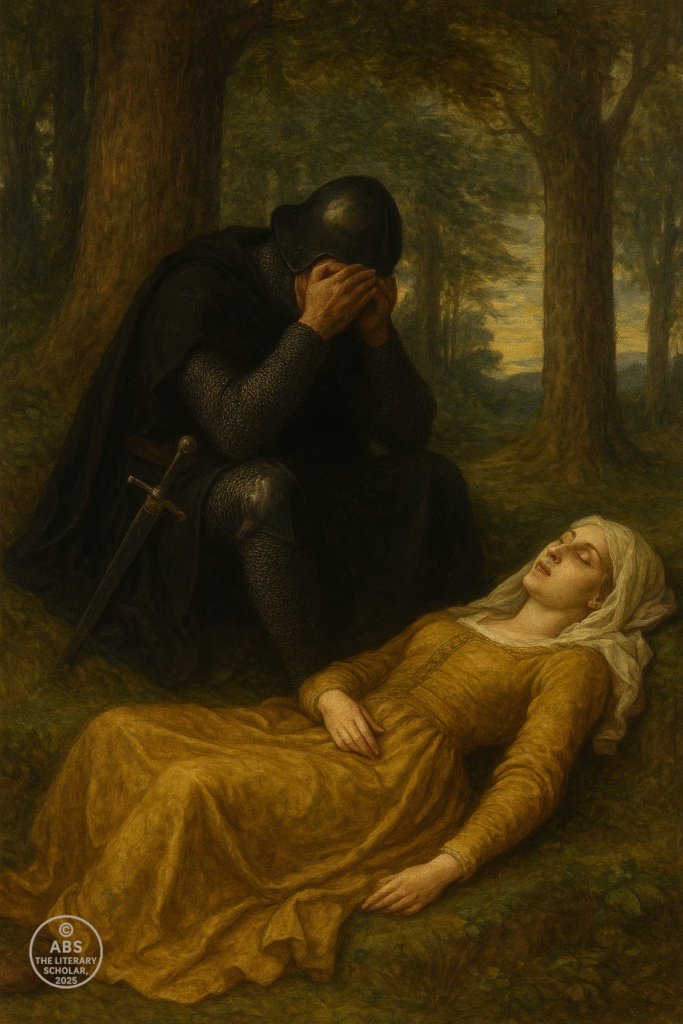
“The Parliament of Fowls,”
Geoffrey Chaucer’s “The Parliament of Fowls,” “The House of Fame,” and “The Legend of Good Women” are three of his shorter works that showcase his poetic versatility, narrative skills, and exploration of themes like love, destiny, and human nature. Let’s delve into each work and provide individual summaries:
“The Parliament of Fowls”:
“The Parliament of Fowls” is a dream vision poem in which the narrator dreams of a parliament of birds gathering to choose their mates on Valentine’s Day. The poem is notable for its allegorical elements and its exploration of themes related to love, choice, and natural order.
Summary: The narrator dreams of being transported to a beautiful garden where birds from various species have gathered for a parliament. The assembly of birds debates over choosing their mates. The goddess Nature presides over the gathering and suggests that the eagle, a symbol of nobility, should have the first choice. As the eagle deliberates, other birds express their opinions on love and choice. However, the poem ends ambiguously, leaving the actual choices of the birds unresolved.
Themes: The poem explores the complexities of love, the tension between natural instincts and free will, and the concept of destiny. Chaucer uses the birds as allegorical figures to comment on human behaviors and attitudes toward love and relationships.
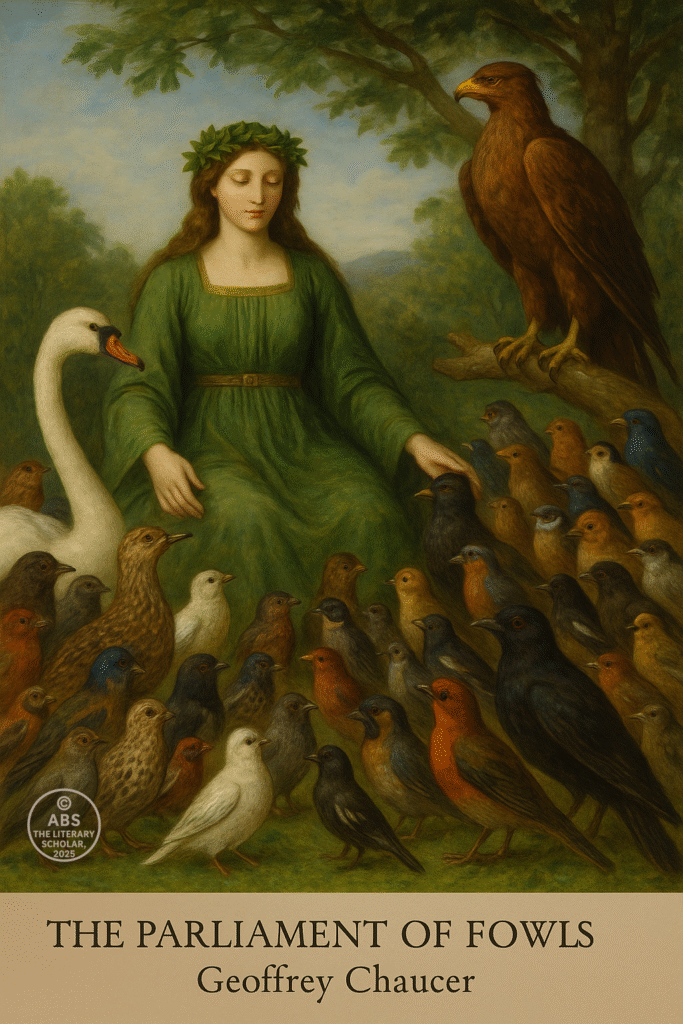
“The House of Fame”
“The House of Fame” is another dream vision poem that follows the narrator’s journey to the House of Fame, a celestial structure where stories and information are shared and disseminated. The poem combines allegory, satire, and social commentary.
Summary: The narrator dreams of a giant eagle carrying him to the House of Fame. Inside the House, the narrator witnesses the activities of various mythological and historical figures who seek recognition for their deeds. The House is filled with voices and stories, representing the fleeting and mutable nature of fame. The poem ends with the eagle’s warning that fame is unreliable and easily manipulated.
Themes: “The House of Fame” explores the nature of fame, the power of storytelling, and the relationship between truth and fiction. Chaucer also engages in satirical commentary on human vanity, rumor, and the pursuit of recognition.
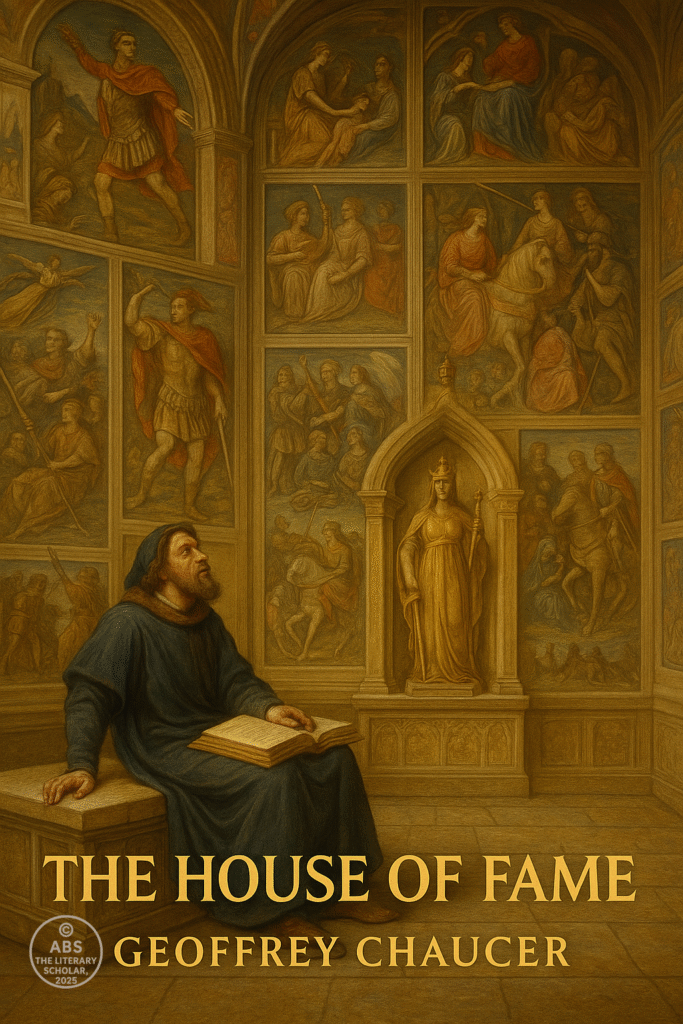
“The Legend of Good Women”
Overview: “The Legend of Good Women” is a series of interconnected narrative poems that focus on the stories of virtuous and tragic women from history and mythology. The poems were intended to depict the loyalty and faithfulness of women, in response to criticisms raised by previous works.
Summary: The prologue of the poem presents the narrator’s intention to write about women who were wrongly accused of being unfaithful to their lovers. Chaucer then presents the stories of several women, including Cleopatra, Thisbe, Dido, and more, highlighting their loyalty and tragic circumstances. The poem ends with the narrator encountering the god of Love, who chastises him for attempting to undermine Love’s authority.
Themes: “The Legend of Good Women” explores themes of loyalty, fidelity, and the portrayal of women in literature. Chaucer uses these stories to engage with issues related to gender, love, and the societal expectations placed on women.
These works collectively showcase Chaucer’s versatility in crafting narrative poems that blend allegory, satire, and social commentary. Each work offers a unique exploration of themes relevant to human experiences, making them valuable contributions to Chaucer’s literary legacy.
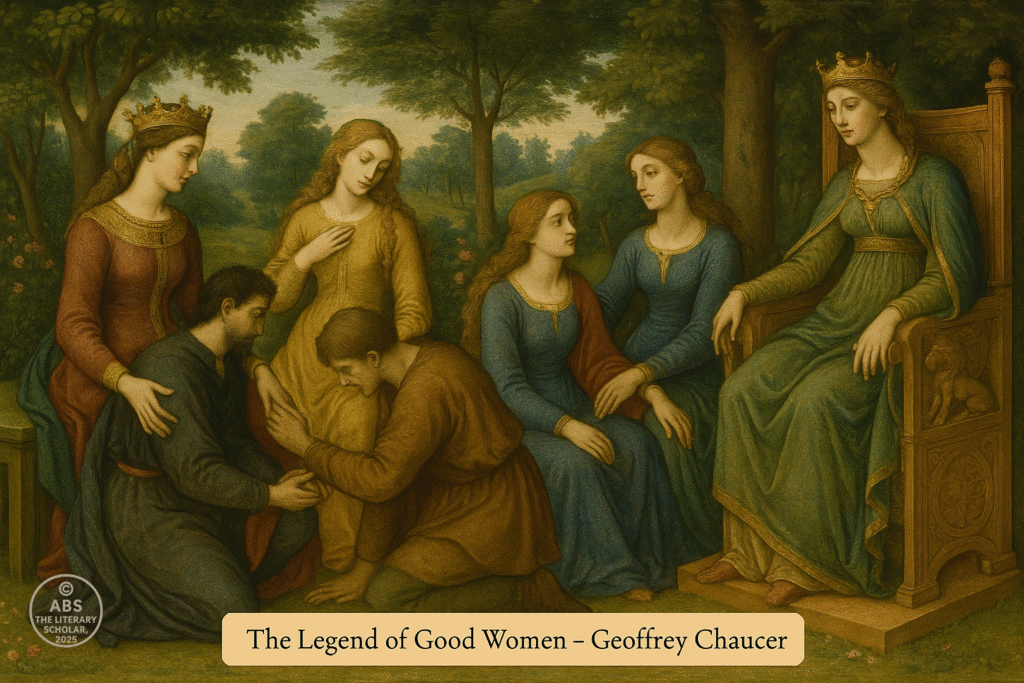
Geoffrey Chaucer likely began writing “The Canterbury Tales” in the late 1380s and worked on it intermittently until his death in 1400. The Prologue, serving as the introduction to this collection of stories, was likely written during this period as well.
“The Canterbury Tales” was written in Middle English and is considered one of the most important works of medieval literature. The Prologue, specifically, sets the stage for the tales that follow. It introduces the diverse group of pilgrims who are traveling to the shrine of Thomas Becket in Canterbury Cathedral, and it establishes the storytelling contest that frames the narrative structure of the work.
In Geoffrey Chaucer’s “The Canterbury Tales,” the Prologue introduces a group of 29 pilgrims, including Chaucer, who are journeying to the shrine of Thomas Becket in Canterbury Cathedral. These pilgrims encompass a wide spectrum of social classes, professions, and personalities, presenting a vivid cross-section of medieval society. The Prologue provides detailed descriptions of each individual, offering insights into their appearances, backgrounds, and attitudes. Along with Chaucer, the narrator, and the innkeeper, the Host, there are a total of 31 individuals mentioned in the Prologue. This diverse cast forms the ensemble of pilgrims traveling to Canterbury, each representing distinct social classes, professions, and personalities, creating a multifaceted and compelling group that sets the stage for the tales that follow in the collection.
Pilgrims’ Names and Professions:
Chaucer’s Prologue introduces us to a variety of pilgrims, each representing a different social class and profession. Some of the notable pilgrims and their professions include:
Knight: A noble warrior with chivalrous ideals.
Squire: The Knight’s son and a young lover and fighter.
Prioress (Nun): The head of a convent, striving for elegance.
Monk: A clergyman who prefers hunting to religious duties.
Friar: A mendicant friar skilled at manipulating people.
Merchant: A businessman well-versed in financial matters.
Clerk: A poor scholar dedicated to learning.
Man of Law (Sergeant-at-Law): A knowledgeable lawyer.
Franklin: A wealthy landowner who enjoys pleasure.
Haberdasher, Carpenter, Weaver, Dyer, and Tapestry-Maker: Skilled craftsmen.
Cook: A chef skilled at making delicious meals.
Shipman: An experienced sailor and captain.
Doctor (Physician): A knowledgeable medical professional.
Wife of Bath: A woman with multiple husbands and a penchant for storytelling.
Parson: A humble and devout country priest.
Plowman: The Parson’s brother, a farmer and laborer.
Miller: A brawny man who operates a mill.
Manciple: A steward in charge of purchasing supplies.
Reeve: A clever steward of a manor.
Summoner: An official who summons individuals to the church court.
Pardoner: A seller of indulgences and religious relics.
Host (Harry Bailly): The owner of the Tabard Inn, who proposes the storytelling contest.
These pilgrims collectively represent a wide range of social classes and professions, offering a comprehensive portrayal of medieval society as they embark on their pilgrimage to Canterbury Cathedral.
The Tabard Inn and the Host:
The pilgrims gather at the Tabard Inn in Southwark, London, at the beginning of their journey. The inn is described as a busy and bustling place where travelers rest and prepare for their pilgrimage. The Host, Harry Bailly, is the innkeeper. He suggests the idea of a storytelling contest to pass the time during the journey to Canterbury and back. The Host will serve as the judge of the contest, deciding whose tale is the best, and he will provide a feast for the winner upon their return.
The Prologue’s intricate character descriptions and the portrayal of the diverse group of pilgrims offer insights into the social dynamics of medieval England while also setting the stage for the various tales that comprise the rest of “The Canterbury Tales.”
“The Canterbury Tales” is a collection of stories written by Geoffrey Chaucer in the late 14th century. It is one of the most important works of Middle English literature and is known for its diverse characters, narrative innovation, and social commentary. The collection is framed by the concept of a storytelling contest among a group of pilgrims traveling to the shrine of Thomas Becket in Canterbury Cathedral.
The collection opens with a General Prologue, where the narrator, who is also a character named Geoffrey Chaucer, describes the arrival of spring and the desire of people to go on pilgrimages. The narrator finds himself at the Tabard Inn in Southwark, London, where he meets a group of 29 pilgrims who are also staying at the inn. The pilgrims come from various walks of life and social classes.
The Host of the Tabard Inn, named Harry Bailly, suggests that they pass the time on their journey to Canterbury by engaging in a storytelling contest. Each pilgrim will tell two tales on the way to Canterbury and two on the way back. The Host will serve as the judge, and the pilgrim with the best tale will win a free meal upon their return.
Diversity: The collection features a diverse group of pilgrims, each representing a different social class, profession, and personality. This diversity offers a microcosm of medieval society and allows Chaucer to explore various aspects of human nature and behavior.
Narrative Innovation: Chaucer’s use of the framing device of the pilgrimage and the storytelling contest is innovative and provides a structure for the collection. The tales within the tales allow for a wide range of genres, themes, and tones.
Social Commentary: Chaucer’s character sketches and tales provide social commentary on the flaws, virtues, and hypocrisies of medieval society. The pilgrims’ stories often reveal truths about human behavior, relationships, and societal norms.
Satire and Humor: Chaucer employs satire and humor to criticize the vices and follies of his characters and society. The tales often playfully mock various aspects of medieval life.
Themes: The tales encompass a wide array of themes, including love, morality, power, fate, and the complexities of human relationships. Each pilgrim’s story reflects their personality and worldview.
Unfinished Work
Chaucer intended for each pilgrim to tell two tales on the way to Canterbury and two on the way back, resulting in a total of 120 stories. However, Chaucer completed only a fraction of this ambitious project. The collection includes a mix of completed and unfinished tales, showcasing Chaucer’s range as a storyteller.
“The Canterbury Tales” is a seminal work in English literature that offers a window into the cultural, social, and literary landscape of medieval England. Its mixture of storytelling, satire, and commentary continues to captivate readers and scholars to this day.
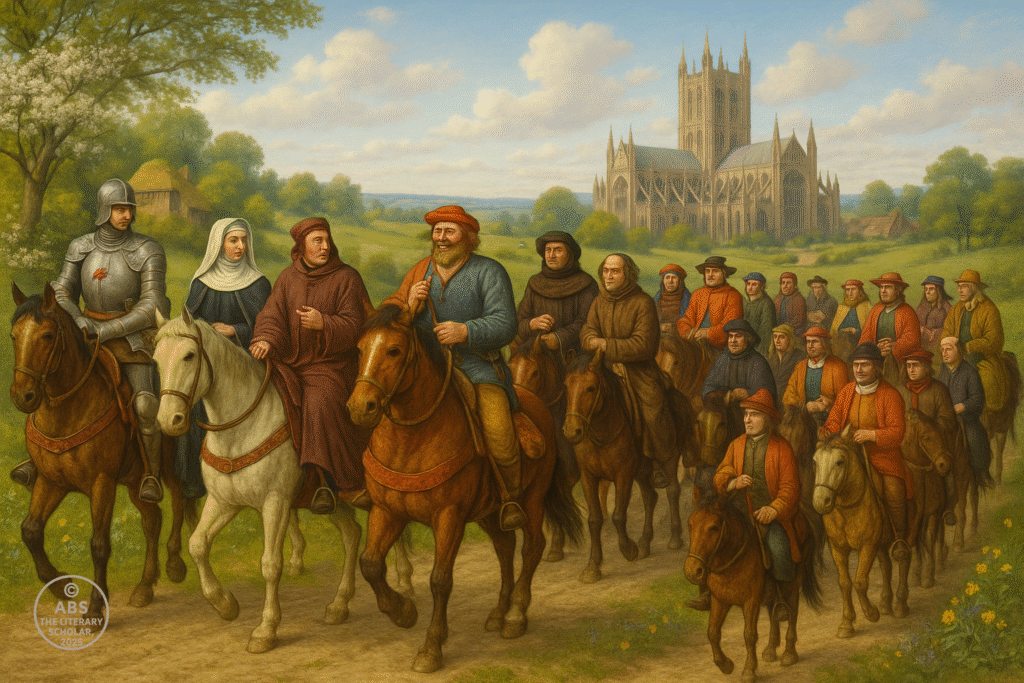
The Knight’s Tale
The Knight in Geoffrey Chaucer’s “The Canterbury Tales” is one of the pilgrims embarking on the journey to Canterbury. Known as the epitome of chivalry and nobility, the Knight is introduced in the General Prologue as a valiant and honorable figure. His tale, “The Knight’s Tale,” is the first story told by the pilgrims in the collection and reflects his character and values.
The Knight’s Tale is a romance that draws inspiration from Greek mythology and ancient literature, specifically the story of Theseus, the Duke of Athens, and his friend Pirithous. Theseus conquers the land of the Amazons, and in the process, he captures their Queen, Hippolyta. He is also able to rescue two captured cousins, Emelye and her sister.
As the story progresses, both Arcite and Palamon fall in love with Emelye. Their intense love for her eventually strains their friendship, leading to a bitter rivalry. Arcite is released from prison after some time and disguises himself to work in Theseus’s court. Meanwhile, Palamon escapes and hides in a grove. With the help of a deity, the gods agree that Arcite should marry Emelye. However, Palamon prays to Venus for Emelye’s love.
The gods intervene again, this time with Mars favoring Arcite, and Venus favoring Palamon. A jousting tournament is arranged, and Theseus is present to judge it. As the two rivals face off, Arcite is victorious but meets with a fatal accident shortly afterward. On his deathbed, he blesses the union of Palamon and Emelye, ending the rivalry.
Themes in “The Knight’s Tale”:
Chivalry and Nobility: The tale embodies the chivalric ideals of honor, courage, and loyalty. The characters are nobles who follow codes of conduct and exhibit virtues.
Love and Rivalry: The central theme revolves around the love triangle between Arcite, Palamon, and Emelye. Their rivalry showcases the complexity of human emotions.
Fate and Fortune: The tale explores the role of fate and destiny in shaping human lives. The gods’ intervention emphasizes the idea that humans are subject to divine will.
Conflict and Resolution: The tale delves into the conflict between friendship and romantic love and how it can lead to resolution and transformation.
Order and Disorder: The Knight’s Tale reflects a world where order is restored after conflicts and challenges.
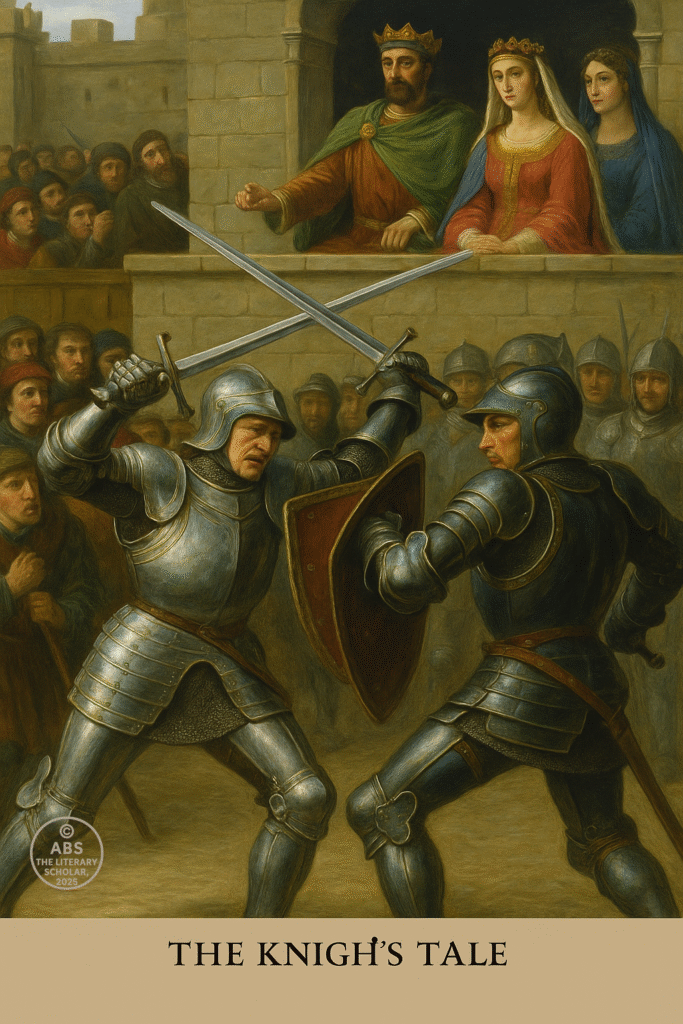
The Prioress’s Tale
The Prioress’s Tale, told by the Nun (Prioress) in Geoffrey Chaucer’s “The Canterbury Tales,” is a brief but emotionally charged story with religious and moral themes. It reflects the Prioress’s devout and sentimental nature and is centered around a miracle attributed to the Virgin Mary.
The tale is set in a city that reveres the Virgin Mary. In this city lived a pious and virtuous Christian boy who sang hymns to the Virgin Mary as he walked to school. He learned the Latin prayer “O Alma Redemptoris” from his schoolmates and repeated it often.
One day, as the boy was passing through a Jewish quarter, he was confronted by a group of Jews who were upset by his devotion to Mary. They plotted to kill him. The boy continued to sing his hymns to Mary, and the Jews, infuriated, seized him, cut his throat, and threw his body into a privy.
However, the Virgin Mary took special care of the boy. She placed a grain under his tongue, preserving him from harm. When the boy’s mother, distressed by his absence, found his body in the privy, she prayed to Mary for help. The boy miraculously began to sing “O Alma Redemptoris” from inside the privy. The miraculous singing led the people to discover the boy’s body.
The news of the miracle spread, and many people came to honor the boy’s body and sing hymns to Mary. The Jews responsible for the boy’s death were apprehended and executed, while the boy was declared a martyr.
Themes in “The Prioress’s Tale”:
Devotion and Miracles: The tale highlights the Virgin Mary’s role as a protector and intercessor for the faithful. The boy’s piety and devotion lead to a miraculous intervention that ultimately brings about justice.
Anti-Semitic Elements: The tale features negative portrayals of Jews, which were common in medieval literature. The Jews’ antagonistic role serves as a contrast to the piety of the Christian boy.
Martyrdom: The boy’s willingness to die for his faith and his miraculous singing from beyond the grave emphasize the theme of martyrdom and divine intervention.
Motherhood and Mercy: The mother’s grief and subsequent prayers to Mary highlight themes of motherhood, mercy, and the power of faith.
“The Prioress’s Tale” reflects the Prioress’s desire for elegance and her sentimentality. The tale emphasizes the power of faith, divine intervention, and the veneration of the Virgin Mary. It also engages with the complexities of religious relationships and the contrast between faith and cruelty.
The Nun’s Priest’s Tale
The Nun’s Priest’s Tale, told by the Nun’s Priest in Geoffrey Chaucer’s “The Canterbury Tales,” is a lively and humorous story that features a clever rooster named Chanticleer and his misadventures. This tale is a fable, characterized by its moral lesson and anthropomorphic animal characters.
The tale is set in the yard of a poor widow’s cottage and revolves around a magnificent rooster named Chanticleer. Chanticleer has a beautiful and melodious crow that can rival any church bell. He rules over a harem of hens and enjoys telling them stories about dreams, warning them against potential dangers.
One night, Chanticleer has a vivid dream of a beast that threatens to devour him. He describes the dream to his favorite hen, Pertelote, who dismisses it as the result of bad digestion. However, Chanticleer insists that dreams can have prophetic meanings and quotes stories to support his argument.
Despite Pertelote’s skepticism, Chanticleer’s foreboding becomes a reality. A cunning fox named Reynard approaches Chanticleer and flatters him, pretending to be a friend. Chanticleer is charmed by the fox’s words and agrees to sing with his eyes closed. Seizing the opportunity, the fox grabs Chanticleer and runs off into the woods.
As Chanticleer laments his fate, the fox’s cunning is revealed. Chanticleer cleverly suggests that the fox should boast about his victory before other animals, leading the fox to open his mouth in pride. Taking advantage of this moment, Chanticleer escapes from the fox’s jaws and flies to a tree, out of the fox’s reach.
Themes in “The Nun’s Priest’s Tale”:
Deception and Flattery: The tale explores the themes of deception and flattery, as the fox uses these tactics to manipulate Chanticleer.
Wisdom and Foolishness: The tale contrasts Chanticleer’s wisdom in recognizing the potential danger of his dream with his later foolishness in trusting the fox’s flattery.
Fate and Free Will: The debate between Chanticleer and Pertelote about the significance of dreams touches on the concepts of fate and free will.
Irony and Humor: The tale is rich in irony, as the clever rooster falls for the fox’s trick. The humor arises from the anthropomorphism of the animal characters and their interactions.
Moral Lesson: The tale concludes with a moral lesson about the dangers of excessive trust and the consequences of being easily deceived.
“The Nun’s Priest’s Tale” combines entertaining storytelling with moral reflection, showcasing Chaucer’s ability to create engaging narratives that engage with human behavior and virtues. Through its vivid characters and amusing situations, the tale provides both entertainment and food for thought.
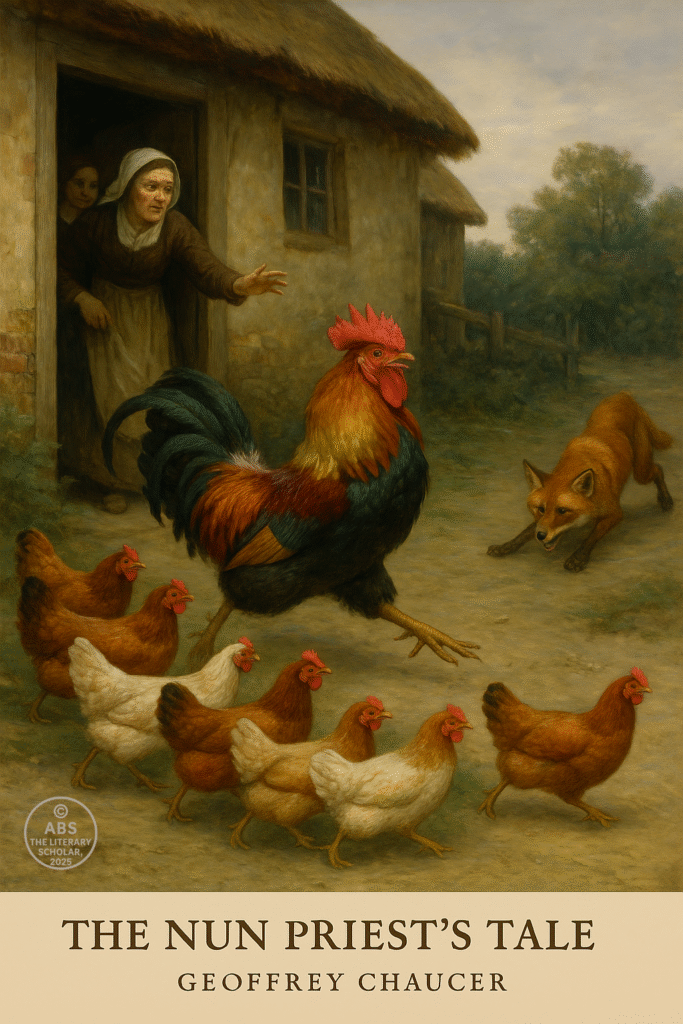
The Tale of Melibee
In Geoffrey Chaucer’s “The Canterbury Tales, “The Tale of Melibee.” a tale is presented in prose rather than verse: This tale is notable for its departure from the poetic form and its presentation as a moral and instructional story in prose.
Summary of “The Tale of Melibee”:
“The Tale of Melibee” is told by the host, Harry Bailly, in response to the request of the company for a tale of moral instruction. The host mentions that he learned the tale from his wife. The story revolves around a wealthy man named Melibee and his wife, Prudence.
Melibee’s house is invaded by his enemies, who assault him and his wife. Melibee is severely injured, and his daughter is violated. Prudence, however, advises her husband to avoid hasty retaliation and seeks peace instead. She emphasizes the importance of patience, rationality, and avoiding excessive vengeance.
Prudence consults with advisors, who suggest seeking arbitration and compromise. Melibee is initially resistant to Prudence’s advice, but she persuades him to consider the long-term consequences of his actions. Ultimately, Melibee follows Prudence’s counsel, and they make peace with their enemies through negotiations.
Themes in “The Tale of Melibee”:
Wisdom and Prudence: The tale highlights the importance of wisdom and prudent decision-making, particularly in the face of adversity. Prudence’s advice demonstrates the value of careful consideration and rational thinking.
Conflict Resolution: The story explores strategies for conflict resolution, emphasizing the alternatives to hasty revenge and violence. Negotiation and compromise are presented as viable alternatives to vengeance.
Patience and Temperance: The tale promotes virtues such as patience, temperance, and self-control. Prudence’s guidance is grounded in these virtues, helping to prevent rash actions.
Moral Instruction: “The Tale of Melibee” is primarily didactic in nature, aiming to provide moral and ethical lessons for the audience. It encourages reflection on the consequences of one’s actions.
Gender Roles: The tale also touches on the role of women in decision-making and conflict resolution. Prudence’s intelligence and insight stand out as she influences her husband’s choices.
The Parson’s Tale
“The Parson’s Tale” in Geoffrey Chaucer’s “The Canterbury Tales” is also written in prose, unlike the majority of the other tales in the collection, which are written in verse. It is presented as a lengthy religious discourse, a sermon, rather than a narrative story. This makes it distinct from the rest of the tales and emphasizes its didactic and instructional nature. The Parson’s Tale focuses on themes of sin, repentance, and moral guidance, providing listeners with a theological perspective on these matters.
“The Parson’s Tale” is a lengthy sermon presented in Geoffrey Chaucer’s “The Canterbury Tales.” It is delivered by the Parson, who is one of the pilgrims in the collection. This tale stands out from the others in the collection, as it is not a traditional story but rather a religious discourse on the seven deadly sins and their corresponding virtues.
“The Parson’s Tale” is a sermon focused on the theme of penitence and the importance of recognizing and repenting for one’s sins. The Parson begins by discussing the nature of sin and its consequences, emphasizing the gravity of sin and its potential to lead to damnation. He then introduces the concept of the seven deadly sins, which are pride, envy, anger, sloth, avarice (greed), gluttony, and lechery (lust).
The Parson goes on to explain each of these sins in detail, providing definitions and examples. For each sin, he offers spiritual advice on how to combat it through the practice of virtues. He presents these virtues as the antidotes to the deadly sins:
Pride – Humility: The Parson emphasizes humility as the remedy for pride, encouraging listeners to recognize their own shortcomings.
Envy – Love of God and Neighbors: The Parson recommends replacing envy with love for God and others, which leads to mutual support and compassion.
Anger – Meekness and Patience: He advocates for meekness and patience as the means to overcome anger and hostility.
Sloth – Diligence: The Parson stresses the importance of diligence and hard work to overcome sloth and laziness.
Avarice (Greed) – Generosity: He suggests cultivating generosity and sharing wealth to counter avarice.
Gluttony – Temperance: The Parson advises temperance and moderation in all things, including food and drink.
Lechery (Lust) – Chastity: The Parson promotes chastity and self-control to combat lust.
The sermon concludes with the Parson addressing the congregation and urging them to engage in sincere repentance and confession of their sins. He emphasizes the need for genuine contrition and a firm commitment to amending one’s ways.
Themes in “The Parson’s Tale”:
Penitence and Redemption: The central theme is the importance of recognizing one’s sins, repenting sincerely, and seeking redemption through God’s grace.
Moral and Spiritual Guidance: The Parson’s Tale offers practical advice for leading a virtuous and righteous life, reflecting its didactic nature.
Vices and Virtues: The tale highlights the contrast between the seven deadly sins and the virtues that counteract them.
Spiritual Teaching: “The Parson’s Tale” serves as a theological and moral instruction on sin, repentance, and spiritual growth.
Spiritual Authority: The Parson, as a religious figure, exercises his authority to provide guidance and pastoral care to the listeners.
“The Parson’s Tale” serves as a profound reflection on the nature of sin, human weakness, and the path to spiritual growth and salvation. It adds depth to the collection of tales by offering a serious and didactic perspective on religious matters.
The Monk’s Tale, told by the Monk in Geoffrey Chaucer’s “The Canterbury Tales,” is a unique narrative that departs from the traditional storytelling format. Rather than recounting a single story, the Monk’s Tale is a series of short tragedies featuring historical figures and their falls from grace. These stories collectively convey a somber reflection on the fleeting nature of worldly glory and fortune.
The Monk’s Tale begins with a general prologue in which the Monk expresses his desire to share tales of famous men whose destinies were marked by tragedy. He emphasizes that even great rulers and heroes are not immune to fate’s twists and turns.
The tales that follow include stories of numerous historical figures, each featuring a downfall or a reversal of fortune. Some of the figures and events mentioned in the Monk’s Tale include Lucifer’s fall from Heaven, Adam’s expulsion from Eden, Hercules’ death, the destruction of Troy, Julius Caesar’s assassination, and many others.
Throughout the tales, the Monk interjects reflections on the transitory nature of human achievements, wealth, and power. He stresses that even the mightiest individuals and empires eventually succumb to time and fate.
Fate and Fortune: The Monk’s Tale explores the theme of fate and fortune, demonstrating how even the most powerful and renowned figures are subject to the whims of destiny.
Hubris and Humility: The tales emphasize the danger of hubris and excessive pride, as many of the featured characters meet tragic ends due to their arrogance.
Memento Mori: The tales serve as a reminder of mortality, highlighting the inevitability of death and the impermanence of worldly achievements.
Reflection on History: The Monk’s Tale draws from historical accounts to provide a broader perspective on the rise and fall of great individuals and civilizations.
Spiritual Contemplation: The Monk’s reflections serve as a contemplative backdrop, encouraging listeners to reflect on the impermanence of worldly pursuits and the importance of spiritual matters.
Irony: The Monk himself is characterized by his penchant for hunting and love of luxury, which contrasts with the moral and spiritual lessons of the tales he shares.
The Monk’s Tale stands out for its thematic focus and its departure from traditional narrative storytelling. Its somber tone and meditation on the ephemerality of human achievements contribute to the complexity and depth of “The Canterbury Tales” as a whole.
The Friar’s Tale:
The Friar’s Tale is a short, comedic narrative that centers on a cunning summoner, who is a church official responsible for summoning individuals to appear before the church court. The tale satirizes the corruption and dishonesty prevalent in the church system of Chaucer’s time.
In the tale, a summoner meets a yeoman in the woods, who turns out to be a demon. The demon shares a story of a corrupt summoner named Thomas, who abuses his power for personal gain. Thomas partners with a corrupt archdeacon to extort money from innocent villagers under the pretense of citing their minor offenses. Their scheme is designed to extract wealth from the poor villagers.
One day, as Thomas is on his way to collect more money, he encounters a widow who is too poor to pay. Instead of demanding money from her, he requests a kiss. The widow, frustrated, tells him to close his eyes, and while he does so, she farts in his face. The villagers witness this incident and mock the humiliated summoner.
Realizing he has been deceived, Thomas angrily confesses his sins to the archdeacon, who rebukes him for his foolishness. The demon concludes the story by stating that summoners are in league with hell due to their dishonest practices.
Themes in “The Friar’s Tale”:
Corruption and Hypocrisy: The tale satirizes the corruption within the church system, as officials like the summoner and archdeacon exploit their positions for personal gain.
Deception and Retribution: The summoner’s humiliation through deception and mockery serves as a form of retribution for his dishonest actions.
Social Critique: Chaucer criticizes the moral degradation and greed prevalent in society, particularly within the church hierarchy.
The Merchant’s Tale
The Merchant’s Tale is a fabliau, a genre known for its humorous and often bawdy narratives. The tale explores themes of marriage, deceit, and consequences of infidelity.
The tale revolves around a wealthy old knight named January, who marries a young and beautiful woman named May. January is infatuated with May and believes she will bring him happiness. However, May is secretly attracted to January’s young squire, Damyan.
May and Damyan devise a plan to spend time together in secret. May climbs into a pear tree, pretending to be admiring the view. Damyan joins her, and they begin a romantic affair. One day, January goes blind, and May and Damyan continue their relationship without fear of being caught.
One morning, January tells May about a dream he had, in which he regained his sight. May encourages him to climb the pear tree where Damyan is waiting, and they engage in an explicit sexual encounter while January thinks he is regaining his sight.
As the tale concludes, a god of love grants January’s wish to see the truth. He sees May and Damyan together, leading to shock and humiliation. However, May manipulates the situation and pretends that January’s sight is still impaired. She convinces him that he is mistaken, and he believes her, despite the evidence.
Themes in “The Merchant’s Tale”:
Infidelity and Deceit: The tale explores the consequences of infidelity and the deceit used to maintain an affair.
Satire and Irony: The tale uses humor and irony to critique the absurdity of January’s beliefs and the manipulation of his perceptions.
Marriage and Love: The tale examines the complexities of marriage and love, particularly when age and appearance play a role.
Clerk’s Tale
The Clerk’s Tale, told by the Clerk (Scholar) in Geoffrey Chaucer’s “The Canterbury Tales,” is a narrative of patience, virtue, and enduring faithfulness. The tale is known for its focus on the virtuous Griselda and her trials in the face of her husband’s testing.
Summary of “The Clerk’s Tale”:
The tale centers around Walter, the Marquis of Saluzzo, who desires a virtuous wife. He marries Griselda, a humble and obedient woman of low birth. Their marriage is initially happy, and they have a daughter named Giannetta. However, Walter’s happiness prompts him to test Griselda’s loyalty and endurance.
Walter feigns displeasure with his daughter, claiming she should be sent away. He pretends to send Giannetta to be killed but actually sends her to Bologna to be raised in secret. Later, Walter insists on divorcing Griselda and marrying a noblewoman. Griselda, heartbroken but obedient, accepts Walter’s wishes without complaint and returns to her family’s home in poverty.
Years later, Walter reveals the truth to Griselda, explaining that he tested her loyalty and that Giannetta is alive. He introduces Giannetta as her daughter and restores Griselda as his wife. Griselda’s patience, humility, and unwavering loyalty deeply move Walter, who praises her virtues and resilience.
Themes in “The Clerk’s Tale”:
Patience and Virtue: The tale emphasizes Griselda’s extraordinary patience, endurance, and virtuous qualities. She remains steadfast despite immense challenges.
Loyalty and Obedience: Griselda’s unwavering loyalty to Walter and her obedience in the face of his tests showcase her admirable character.
Power and Authority: Walter’s manipulation of power and authority allows him to test Griselda’s loyalty and challenge her resilience.
Gender Roles: The tale reflects the expectations and roles of women in medieval society, where obedience and loyalty were considered virtues.
Suffering and Reward: Griselda’s suffering is eventually rewarded with a reunion with her daughter and the restoration of her status as Walter’s wife.
“The Clerk’s Tale” is often interpreted as a story of religious allegory, illustrating the virtue of patience and drawing parallels to biblical narratives of suffering and faithfulness. Griselda’s story can also be viewed as a commentary on gender relations and social hierarchies of the time. Despite its simplicity, the tale offers a complex exploration of themes such as humility, endurance, and the potential transformation of characters.
Through the character of Griselda, Chaucer provides an example of enduring faithfulness and virtue, prompting readers to reflect on the nature of sacrifice, loyalty, and the potential for spiritual growth in the face of adversity.
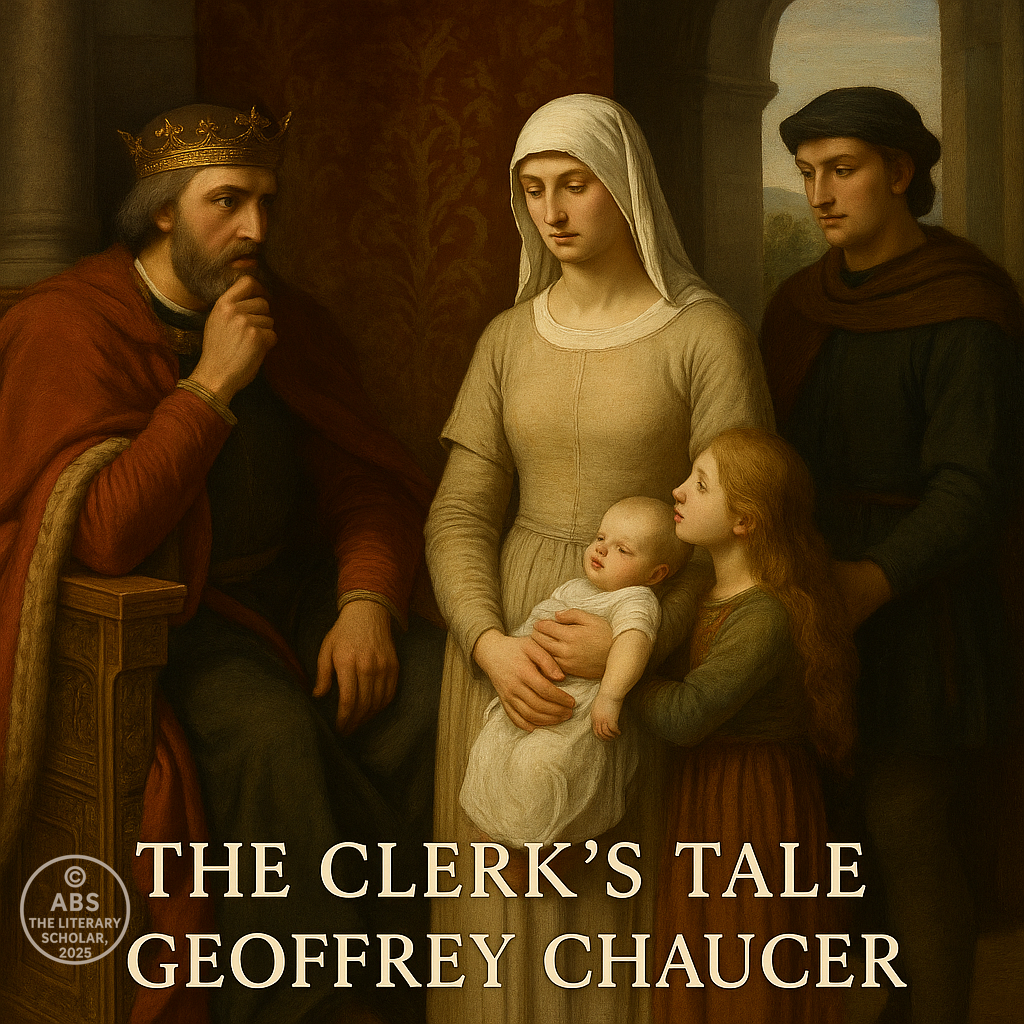
The Franklin’s Tale
The Franklin’s Tale, told by the Franklin in Geoffrey Chaucer’s “The Canterbury Tales,” is a romance that explores the themes of love, marriage, and the delicate balance between trust and jealousy. The tale centers around a knight named Arveragus, his wife Dorigen, and a squire named Aurelius.
Arveragus, a noble knight, marries Dorigen, a beautiful and virtuous woman. Their marriage is characterized by mutual respect and equality. However, Arveragus must leave for foreign lands to seek honor and fortune, leaving Dorigen behind.
During Arveragus’s absence, Dorigen becomes melancholic and unhappy. A young squire named Aurelius falls in love with her and expresses his feelings, but Dorigen rejects him, citing her marital commitment. To divert his sorrow, Aurelius studies magic and eventually discovers an illusionary spell that makes the rocky coast of Brittany, which poses a danger to sailors, disappear.
Upon Arveragus’s return, Dorigen tells him of Aurelius’s advances and her refusal. In an act of generosity, Arveragus suggests that she fulfill her promise to Aurelius, as he values her happiness above all. Dorigen, torn
between her duty to her husband and her desire to keep her promise, reveals the impossible task Aurelius set before her: the removal of the dangerous rocks.
Aurelius, realizing the impossibility of the task, is heartbroken. However, he encounters a magician who sympathizes with his plight and decides to release him from his promise. Dorigen, unaware of Aurelius’s change of heart, prepares to keep her promise by jumping off a cliff into the sea. At the last moment, Aurelius intervenes and confesses that the rocks are no longer a threat.
Touched by Aurelius’s generosity, Dorigen pleads with him to accept a reward for his efforts, which he graciously declines. The tale concludes with a celebration of love and forgiveness, highlighting the virtues of selflessness and integrity.
Themes in “The Franklin’s Tale”:
Love and Generosity: The tale explores different expressions of love, including Arveragus’s selfless love for Dorigen, Dorigen’s loyalty to her husband, and Aurelius’s sacrificial love.
Marriage and Trust: The tale examines the complexity of marital relationships, trust, and the challenge of maintaining trust in the face of outside influences.
Mercy and Forgiveness: The characters’ acts of mercy and forgiveness contribute to the resolution of conflicts and the restoration of harmony.
Magic and Illusion: The tale involves elements of magic and illusion, highlighting the contrast between illusion and reality.
Ethical Dilemma: Dorigen faces an ethical dilemma when she is torn between fulfilling her promise and honoring her marriage.
“The Franklin’s Tale” is a story of love, sacrifice, and forgiveness that showcases the complexities of human relationships. It presents characters who grapple with moral decisions and the delicate balance between personal desires and societal obligations. The tale offers insights into the themes of honor, trust, and the potential for reconciliation in the face of adversity.
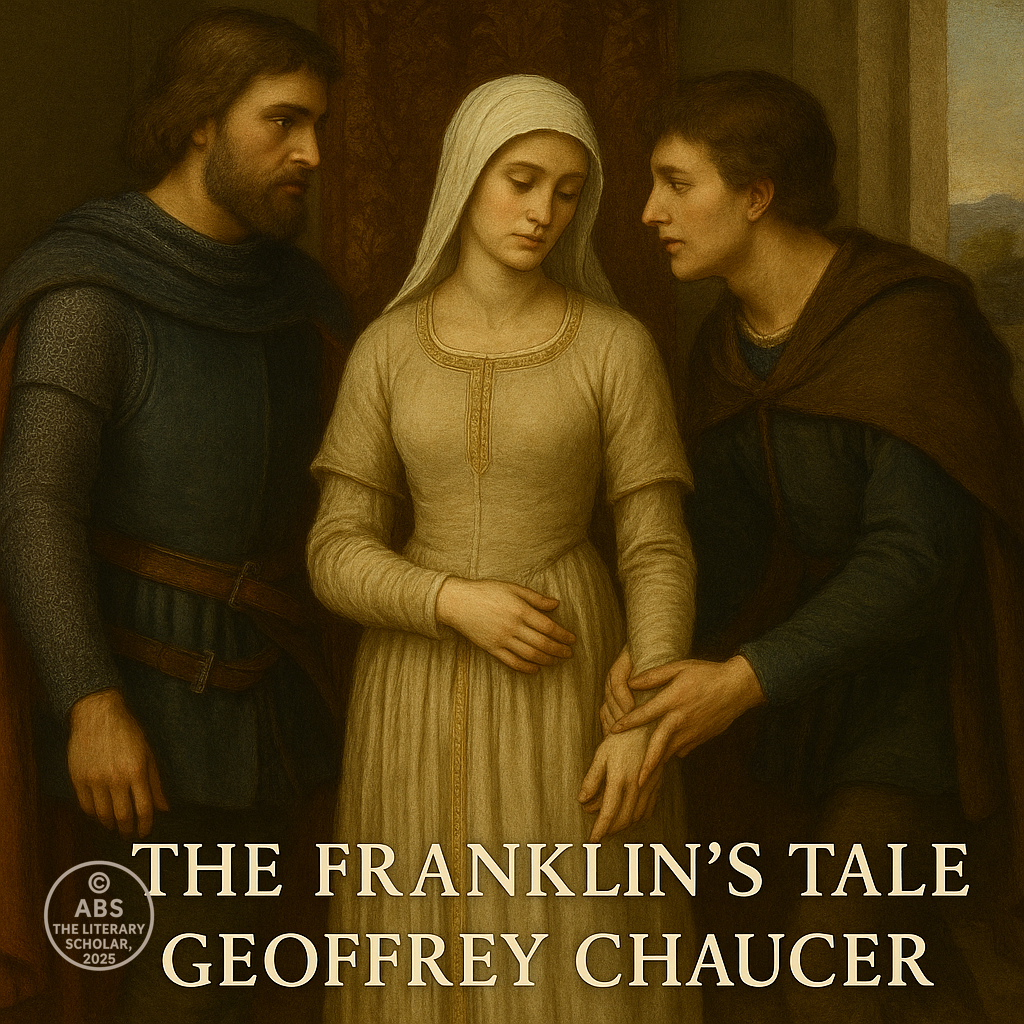
The Wife of Bath’s Tale
The Wife of Bath’s Tale, told by the Wife of Bath in Geoffrey Chaucer’s “The Canterbury Tales,” is a humorous and fantastical story that delves into the themes of sovereignty, power dynamics in marriage, and the quest for control in relationships.
The tale centers around a knight in King Arthur’s court who commits a grave offense by raping a maiden. The queen and her court grant him a reprieve on the condition that he must discover what women truly desire most within a year. The knight embarks on a quest to find the answer.
After a year of fruitless searching, the knight is disheartened. As his deadline approaches, he encounters an old woman in a field who promises to provide the answer in exchange for a boon. Desperate, the knight agrees, and she tells him that women desire sovereignty and mastery over their husbands.
The knight returns to the queen’s court and delivers the answer, which pleases the women in the court. The old woman then approaches the knight and reminds him of his promise to grant her a boon. She requests that he marry her, despite her age and appearance. Reluctantly, the knight agrees.
On their wedding night, the old woman offers the knight a choice: she can remain old and loyal or transform into a young and beautiful woman who might be unfaithful. The choice is his. The knight, torn between the two options, tells her to choose for herself. Her response surprises him: she becomes both young and faithful.
Themes in “The Wife of Bath’s Tale”:
Gender Dynamics: The tale engages with power dynamics between men and women, questioning traditional ideas of gender roles and control in relationships.
Authority and Sovereignty: The story explores the desire for authority and independence, particularly for women who seek mastery over their husbands.
Choices and Consequences: The tale examines the significance of making choices and the consequences that follow, emphasizing the importance of individual agency.
Appearances and Reality: The contrast between the old woman’s appearance and her transformation highlights the theme of appearances versus true character.
Irony and Humor: The tale employs irony and humor to satirize societal norms and expectations, as well as to provoke thought on the nature of love and marriage.
“The Wife of Bath’s Tale” is a thought-provoking narrative that offers a nuanced perspective on relationships, gender roles, and the quest for control and sovereignty. The tale reflects the Wife of Bath’s own views on marriage and her desire for autonomy within a marriage.
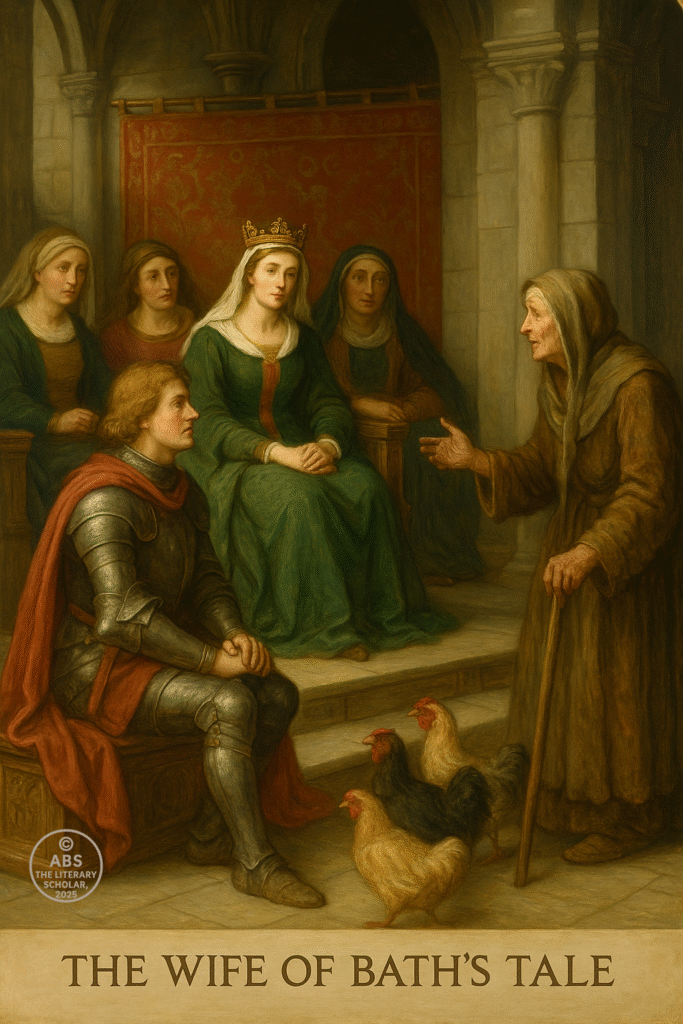
The Cook’s Tale
“The Cook’s Tale” is a fragment of a story in Geoffrey Chaucer’s “The Canterbury Tales.” Unfortunately, the Cook’s Tale is incomplete, and only a few lines of it survive in Chaucer’s text. As a result, there is very little material to provide a detailed summary of the tale.
The Cook’s Tale was intended to be a story told by the Cook, a character in “The Canterbury Tales” who is skilled at making delicious meals. However, the tale was left unfinished, and Chaucer’s manuscript breaks off after only a few lines. This has led to much speculation and debate among scholars about what the complete tale might have been and its themes.”The Physician’s Tale” is a story within Geoffrey Chaucer’s “The Canterbury Tales.” This tale is a moral narrative that explores the concepts of patience, virtue, and divine justice.
“The Physician’s Tale”:
The tale is set in ancient Rome and revolves around the life of a noble knight named Virginius and his virtuous daughter, Virginia. Virginius deeply loves his daughter and raises her with care and affection. Virginia is known for her beauty, virtue, and modesty.
One day, a corrupt judge named Appius desires Virginia for himself. Unable to obtain her through honorable means, Appius devises a plan to claim her as his own. He falsely accuses Virginius of stealing Virginia from another man and brings the case to his own court. Appius, being the judge, rules against Virginius, ordering that Virginia be given to him.
Virginius, desperate to save his daughter from dishonor and injustice, makes a heart-wrenching decision. He takes Virginia aside and reveals the truth: she is not his biological daughter but a foundling he had taken in.
Seeing no other way to protect Virginia’s honor, Virginius kills her in a tragic act of mercy to save her from Appius’s clutches.
The tale ends with the people of Rome rising against Appius and his corrupt rule. Appius is eventually imprisoned and dies in disgrace. The people recognize Virginius as a tragic hero who was forced to make an unimaginable sacrifice.
Themes in “The Physician’s Tale”:
Justice and Injustice: The tale explores the themes of justice and injustice, as the corrupt judge Appius manipulates the law for his own desires.
Sacrifice: Virginius’s agonizing decision to kill his own daughter to protect her from Appius’s intentions showcases the theme of sacrifice for the sake of honor and virtue.
Virtue and Modesty: Virginia’s virtuous and modest character contrasts with Appius’s corruption, highlighting the importance of moral integrity.
Divine Justice: The tale suggests that divine justice prevails in the end, as Appius faces retribution for his wrongdoing.
Parental Love: The tale depicts the depths of a father’s love for his daughter, as Virginius is willing to make the ultimate sacrifice to preserve her honor.
“The Physician’s Tale” provides a somber exploration of morality, justice, and the difficult decisions individuals may face in the pursuit of honor and virtue. It serves as a cautionary tale about the abuse of power and the consequences of corrupt actions.
There is no “Shipman’s Tale” in Geoffrey Chaucer’s “The Canterbury Tales.” The Shipman, also known as the Shipman of Dartmouth, is a character described in the General Prologue of “The Canterbury Tales.” However, Chaucer did not assign a tale to the Shipman, so there is no specific story associated with this character.
“The Canterbury Tales” by Geoffrey Chaucer is indeed an incomplete work. Chaucer began writing “The Canterbury Tales” in the late 14th century, and although he planned to create a collection of 120 stories (two from each of the 30 pilgrims, along with prologues and a conclusion), he was only able to complete a portion of them before his death. The work is essentially a collection of stories being narrated by a diverse group of pilgrims as they travel to the shrine of Thomas Becket in Canterbury.
Chaucer completed a total of 24 tales, including the prologue to each tale, before he passed away. The tales vary in genre, tone, and subject matter, showcasing Chaucer’s skill in adapting various narrative styles. The tales range from romances and fabliaux (short humorous narratives) to moral allegories and parodies of medieval genres.
Despite its incompleteness, “The Canterbury Tales” remains one of the most significant and celebrated works in English literature. The tales that Chaucer completed provide valuable insights into medieval society, social dynamics, and individual character types. The diversity of characters and their stories reflects a cross-section of medieval England, offering glimpses into different professions, classes, and moral perspectives.
Chaucer’s unfinished masterpiece has continued to captivate readers for centuries, and its open-ended nature invites interpretation and speculation about how the overarching narrative might have concluded had Chaucer completed the work according to his original plan.
Certainly, Geoffrey Chaucer’s poetry is filled with beautiful and timeless quotes. Here are a few notable ones:
“The lyf so short, the craft so long to lerne.” – From “The Parliament of Fowls”
Translation: “Life is so short, and the learning process is so long.”
“Forbid us something, and that thing we desire.” – From “Troilus and Criseyde”
This quote reflects the idea that human nature often leads us to desire what is forbidden.
“And gladly wolde he lerne, and gladly teche.” – From “The Canterbury Tales”
This quote describes the scholarly and wise Clerk, highlighting his eagerness to learn and teach.
“Time and tide wait for no man.” – From “The Canterbury Tales”
This proverbial phrase underscores the unstoppable nature of time.
“And from his full heart’s depths in humble wise, His lesson he began.” – From “The Canterbury Tales”
This quote captures the sincerity and humility of the Pardoner’s opening words as he begins his tale.
“Love is the root of all joy and sorrow.” – From “Troilus and Criseyde”
Chaucer beautifully encapsulates the dual nature of love as a source of both happiness and pain.
“The smiler with the knife under the cloak.” – From “The Canterbury Tales”
This line, referring to a deceitful person, portrays the idea of hidden intentions.
“Patience is a conquering virtue.” – From “The Canterbury Tales”
This quote highlights the strength and power of patience.
“People can die of mere imagination.” – From “The Canterbury Tales”
Chaucer reflects on the profound impact of our thoughts and perceptions.
“The greatest scholars are not usually the wisest people.” – From “The Canterbury Tales”
Chaucer humorously comments on the paradox of knowledge and wisdom.
Chaucer’s poetry is a treasure trove of wisdom, insight, and eloquence that continues to resonate with readers across generations.
The literary achievement of Geoffrey Chaucer is not confined to the medieval world; it stands as a foundational moment in the broader arc of English literary history. In Chaucer’s hands, Middle English emerged as a flexible, expressive, and richly nuanced language — capable of capturing the full range of human experience. His works bridge the medieval and the modern, reminding us that literature is most vital when it speaks across boundaries of class, time, and tradition. As we leave this chapter, we carry forward the profound insight that storytelling remains one of humanity’s most enduring arts — and Chaucer, its master in Middle English, continues to inspire and instruct.
From the Professor’s Desk
ABS, The Literary Professor
Share this post / Spread the witty word / Let the echo wander / Bookmark the brilliance
